Traditions are like household clutter — they build up by themselves over time, whether out of practicality of circumstance or mere whim, and when you suddenly stop to take notice of them, you realise you have no idea why you’ve come to have them. Nowhere is this truer than with the typical Western wedding, which over the years has acquired enough odd quirks and eccentricities to thrill any budding anthropologist. There are a large number of popular wedding traditions, many of which trace their origins all over the globe.
With so many people from so many cultures calling the USA their home, it’s perhaps not surprising to see so many little rituals and sayings and habits present at something as universal as a wedding. However due to time and space, we’ll limit ourselves to six of the most popular.
#1 The White Bridal Dress
Said to representative of the bride’s virginity, the wedding dress is actually a recent innovation to modern wedding traditions. It was first introduced by Queen Victoria of the United Kingdom during her wedding to Prince Albert, instead of the kind of silver dresses typically worn at royal weddings. It quickly caught on with the rest of the British population and spread throughout the rest of the world. Originally, brides would simply wear their best dress, and a wide variety of colours were popular.
#2 The Wedding Veil
The wedding veil has roots stretching as far back as ancient Greece and Egypt, so the exact reason why brides wear veils is very much a case of speculation. Some believe that the veil was to prevent the groom from backing out of the marriage because he found he disliked his bride’s appearance. It may also have links to the idea of the bride being solely the domain of her new husband, after being given to him by her father, so only he may look upon her after the ceremony is complete.
In Jewish tradition, it’s customary for the veil to be lifted during the ceremony. This is to affirm that the groom is in fact marrying the correct woman, in reference to a tale in the Torah. In it, Jacob was tricked into marrying Leah by her father, instead of the woman he had wanted to marry: Leah’s younger sister, Rachel.
#3 Jumping the Broom
Some Wiccans like to claim that this is in reference to medieval witchcraft, but the true origin is much more recent and traces its roots in the African slave trade. Because slaves were not allowed to marry by law, many sought alternative ways to strengthen the bonds between them in lieu of a legal wedding. It’s believed that the practise of jumping the broom may have origins in a West African custom of jumping over sticks representing a new home.
Older African Americans disapprove of the practise because of this origin though it has recently acquired a popularity of sorts amongst the younger generations. Through it, they hope to connect to a darker part of their collective history.
#4 Stamping on a Glass
This Jewish wedding tradition has probably been noted by many Gentile observers, and certainly the practise of the groom covering a glass in a handkerchief and stepping on it is found to be a puzzling, if strangely satisfying, custom. So where do the origins lie?
The exact origin is unknown, and like many traditions, can mean different things to different people. To many Jews, though, the breaking of a glass symbolises the destruction of the Temple in Jerusalem. It can also be a representation of the fragility of love and serve as a reminder that a successful marriage needs to be built on stronger things. The handkerchief is purely a utilitarian addition – it keeps all the sharp shards of glass together and makes it easier and safer to clean up.
#5 The Best Man
Not all marriages were happy affairs. The popular wedding tradition of the best man has its origins in the times of family feuds, where it was not uncommon for parents to object to the marriage of their children for some reason or another. The best man would be someone chosen by the groom to help him fight off any attempts at disrupting the marriage.
#6 The Bouquet
In medieval medicine, the concept of germ theory had not yet been established. Rather than by microbes, people believed that diseases spread through bad odours, and would thus carry with them sweet smelling herbs and flowers in a small bundle to smell. A reference to this is found in Ring-a, Ring-a Roses – a pocket full of poses (flowers) was used to ward off plague.
This belief survives today in the bridal bouquet. Originally just garlic and dill, bridal bouquets gradually grew to include a wide variety of flowers and sweet-smelling plants, which largely became aesthetic and ceremonial rather than medical.
But if a bouquet was seen as beneficial, where does tossing it after the wedding come from? Once upon a time, after the ceremonies were complete, women used to descend upon the bride to tear away pieces of her dress (they were considered to be good luck). It seems that tossing the bouquet, and her garter too, was seen as a way to appease the crowd and let the bride leave the ceremony with her dignity and her very expensive dress intact.

